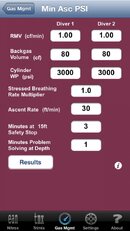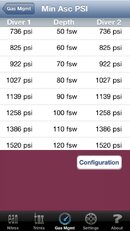The DIR ascent from 100 feet requires 40 cubic feet of gas. Since an Al80, full, has 77 cubic feet of gas in it, this is more than half of the tank. Using the tank factor of 2.5 cubic feet/100 psi, it's 1600 psi, which would leave him 1400 psi to use on his dive. It DOES make for a short dive, which is why small tanks aren't great for deep diving. But if you don't shape the ascent the way the DIR folks do, and use the maximum emergency ascent rate and omit stops, you can cut it down. It's still a big chunk of the tank, though. If you don't reserve that much gas, you really ought to be carrying a pony or something, because if one of you has a freeflow or other major gas loss, you will NOT have enough gas to get both of you to the surface.






